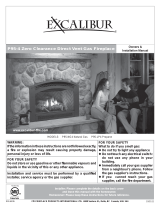
The Riviera 66 is shipped with non-combustible panels which must be installed with the
appliance to conform with to certified safety standards. Two of the panels are secured to the
Placing and Securing Non-Combustible Panels
The recommended order of installation is as follows:
1 – Familiarize yourself with this manual.
2 – Check the minimum installation dimensions and vent installation.
3 – Check your local installation codes.
4 – Check you have the parts and components necessary to complete the installation.
5 – Check the gas and electrical supplies are ready.
6 – Prepare opening (remove any loose materials)
7 – Install Venting
8 – Install base unit and connect vent
9 – Connect gas and electrical supplies.
10 – Install operational components and prepared for first test fire
11 – Check to verify adequate accessibility clearance for service & proper operation
12 – Check operation of unit
13 – Take time to explain operation to customer (most call backs are caused by the customer not understanding the operation
of the unit.)
Existing Gas Supply
Before interrupting the existing gas supply it is recommended that the following be checked.
Shut down all gas appliances and carry out a pressure test to ensure there are no leaks in the system.
Before connecting the appliance to the gas supply line, double check that the appliance you have purchased is designed for the
gas type you are using. The gas type markings are located on the certification label and also on the appliance’s gas valve.
Check the gas pressure immediately upstream to ensure you will be able to supply the minimum inlet pressure for the
appliance.
Check your pipe sizing to ensure sufficient volume will be supplied to the appliance.
Gas Supply Installation
Provide adequate clearance for the proper installation and checking of the gas connection.
Have your gas supplier or a qualified gas fitter run a gas supply line into the gas fireplace. The line must be properly sized
and fitted according to the installation codes. Upstream of the appliance supply connection, the fitter shall provide an easily
accessible manual shut-off valve.
The gas supply pipe should enter the appliance case through the opening at the right side. The supply pipe should be
connected to the appliance gas inlet pipe situated at the right side of the control unit. Supply line connection to the inlet pipe
is 3/8 NPT.
Use only new black iron or steel pipes or copper tubing if acceptable – check local codes.
Note that in the USA copper tubing must be internally tinned for protection against sulfur compounds.
Unions in gas should be of ground joint type. Sealant used must be resistant to the action of all gas constituents including LP
gas. Sealant should be applied lightly to male threads to ensure excess sealant does not enter gas lines.
Pressure testing the supply line for leaks
The appliance and its individual shut-off valve must be disconnected from the gas supply piping system during any pressure
testing of the system at test pressures in excess of ½ psig (3.4kPa). The appliance must be isolated from the gas supply piping
system by closing its individual manual shut-off valve during any pressure testing of the gas supply piping system at test
pressures equal to or less than ½ psig (3.5kPa). Failure to do so will damage the appliance’s gas valve. Such damage is not
covered by the manufacturer’s warranty.
When testing for leaks:
Make sure that the appliance is turned off.
Open the manual shut-off valve.
Test for leaks by applying a liquid detergent or soap solution to all ball joints. Bubbles forming indicate a gas leak.
Correct any leak detected immediately.
Never use an open flame to check for leaks.
The pressure test point locations are built in to the regulator that controls the burner manifold pressure. The correct pressure
range is shown in the table in the specification section of this manual. The pressure check should be made with the burner lit.
See lighting instruction section for full operating details.






















